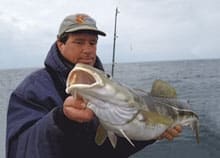
Montauk was a ghost town. The throngs of fishermen and tourists long departed, the streets, motels and shops were empty when SWS Editor David DiBenedetto and I pulled into town on a frigid February night.
|| |—| || |CATCH COLD: Angler Sean McCaffrey hefts a chunky winter cod-his prize for braving the February chill. Photo: Joe Cermele| No matter, we planned to crash for a few hours and then wake up for a cod hunt, and this was the weather cod crazies love. It was a trip sure to test our tolerance for the cold as well as our sanity.
I was questioning the latter on the cod grounds the next morning when my numb hands managed to pick up a subtle tap vibrating through the line from 125 feet below. When I set the hook, I knew why we had come. Judging from the bend in the rod, the fish on the other end had no plans to leave the bottom. When it finally began to show, the mate aboard the Captain Mark leaned over the rail and cried out, “It’s a cod, by God.”
Comeback Cod
There was a time in Montauk when cod were so thick during the winter that surfcasters could hook them right off the beach. But years of commercial overfishing eventually took a toll on the inshore grounds.
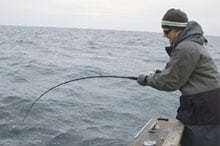
| |
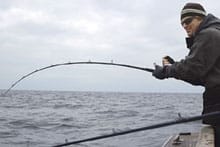
| |
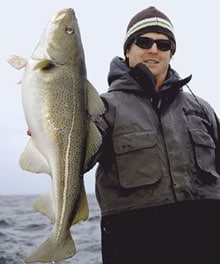
| |BEATEN PATH: Despite its best efforts to stay on the bottom, this 16-pound cod was no match for SWS Editor David DiBenedetto. To beat cod quickly, don’t over-pump the rod. Photo: Joe Cermele| Working on charter, commercial and party boats out of Montauk since 1969, Captain Mark Marose watched the entire fishery change for the worse.
“This town used to revolve around cod in the winter,” he said. “In the early ’70s, there were ten recreational boats chasing them in February.”
Today, the Captain Mark is one of only a handful of boats that sails in the coldest months of the year, but thanks to changes in groundfish regulations and a loss in cod profitability, the number of fish wintering off Montauk is on the upswing. Marose has 37 years of cod-chasing under his belt. I was willing to bet he could help us cash in on this reborn fishery.
Clam on the Rocks
It had been a long, dark ride out to the fishing grounds. But just as the sky changed from pitch-black to dull gray, Marose slowed the 39-foot BHM Sportfisher to a crawl. His face was lit only by the neon glow of the fish-finder that he studied carefully until he saw something he liked. A few blobs appeared on the screen near the bottom 125 feet down, and with that it was lines in.
As we drifted 20 miles southeast of Block Island, Marose and mate Mark Dombrowski grabbed one fresh skimmer clam after another, bashing each with a fish bat and sending the pieces fluttering to the depths. I had just hit bottom when the rod tip jerked and I set on a fish. DiBenedetto followed suit, as did the four other anglers onboard. First it was a round of ling, but it didn’t take long for the cod to begin hitting the deck.
Heavy clam-chumming is a necessity for winter cod, as January and February are spawning months and the fish tend to be more spread out along the bottom. As the season progresses into spring, the fish will begin to key in on herring schools.
“That’s when you’ll see them all clumped up on the bottom,” Marose said. “It will look like a pyramid on the fishfinder.”
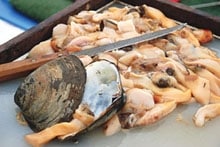
| |SHELL IT OUT: Cod Boats bring out a healthy supply of fresh clams, as heavy chumming is required. Photo: Joe Cermele|
The trick during the colder months is to find rocky ledges and areas of loose gravel bottom, as these are the preferred spawning grounds of Atlantic cod. And thanks to the glaciers that scoured Long Island and Rhode Island millions of years ago, there’s no shortage of prime locations off Montauk. These areas can be found anywhere from ten to 30 miles southeast of Montauk Inlet, or due south of Block Island. Marose learned the local bottom structure well after spending some time working as a commercial lobsterman.
Gearing Down
Catching cod doesn’t require much in the way of fancy tackle. First you’ll need a six- or seven-foot boat rod with a soft tip to detect the subtle strikes, but plenty of backbone to horse the fish off the bottom. The reels Marose keeps aboard-a mix of Penn Senators and Daiwa Sealines-are spooled with 60-pound pink monofilament.
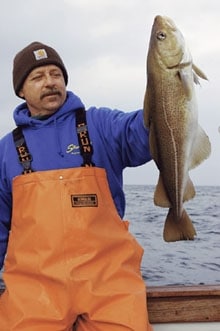
| |CRACK SHOT: Captain Mark Marose uses a fish bat to make quick work of smashing clams for the chum slick. His efforts paid off when an angler onboard hooked this keeper cod. Photo: Joe Cermele| Although DiBenedetto and I came equipped with our own outfits spooled with 30-pound braid, Dombrowski was quick to splice an eight-foot top shot of the heavy mono onto both of our reels. Not only do he and Marose feel the mono has better abrasion resistance, its stretch helps take the initial strain off the rod should a 50-pounder strike 125 to 145 feet down.
Overdoing the terminal tackle on clam rigs can potentially lead to more snags on the hard bottom, so Marose ties directly to the main line without using snaps or swivels. At the end of our top shots, Dombrowski tied a sinker loop and added two snelled dropper leaders made from 80-pound mono. He spaced them a foot apart using stand-out knots to form a quick high-low rig.
The stand-out knot (see SWS November 2006 for tying instructions) takes advantage of the stiffness of the main line and leaders to create a connection that spins less on the drop. The tight coils used in the knot’s formation also keep the dropper leaders and clams out away from the main line to reduce tangling. Marose prefers 6/0 Gamakatsu octopus hooks for his clam rigs because they stay sharp and don’t corrode easily.
“Cod have real bony mouths,” Marose said. “Old-style nickel J-hooks would rust quickly and the points would get dull after a few fish.”
Depending on current and wind speed, eight- to 12-ounce bank sinkers are usually needed to hold bottom. Clam strips are hooked near the end so they don’t spin and twist.
Crank the Metal
Although the optimum time to use diamond jigs for cod is during the spring herring run, Marose opts to have a few of the anglers onboard jig even when the bite is primarily on clams. Six- to nine-ounce jigs are attached to the main line with a sinker loop, while two jelly worms-transparent curly-tail grubs-rigged on 6/0 J-hooks and short pieces of 60-pound mono are tied above the jig with stand-out knots.
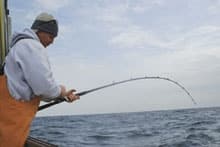
| |
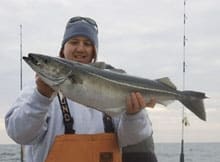
| |FROSTBITE BONUS: Spirited fighters and excellent to eat, Pollock are bonuses on the cod grounds. Seasoned winter angler Ed Schuster fooled this fat Pollock with a diamond jig. Photo: Joe Cermele| The cod can be slow to strike the metal in February, but the jigs are used more as a delivery method for the worms. Marose goes with six-inch jelly worms in fluorescent-red, pink or chartreuse.
“The jelly worms have great action without having to retrieve too quickly,” he said. “Cod like a slow-moving lure. The worms also tend to spin and tangle a lot less often.”
Not only did the diamond jigs and jelly worms add a few more cod to the box, they did a number on the pollock that frequent the same areas. It was when we encountered these fish and Marose dropped a jig that his years of experience really shined.
“The pollock will hit the worms as the jig falls,” Marose said as he thumbed the spool and carefully watched the tip of his rod. “You have to keep an extremely tight line at all times during the drop.”
No sooner had he spoken when he reared back and his rod bowed under the pressure of a bucking fish. He never pumped, but kept the rod low and cranked the 15-pound pollock straight in. With a face like a cobia, the body of a cod and the strength of a schoolie bluefin tuna, pollock are a bonus on the winter cod grounds that make excellent table fare.
After ten hours at sea, we returned with plenty with of cod weighing in the teens and an A+ in chill perseverance.
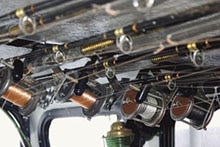
| |POLE VAULT: Sturdy rods and high-capacity reels are best for battling cod in deep water. Photo: Joe Cermele| The take may not have compared to the winter hauls of seasons long ago, but the scene is hopefully set for a full recovery of the fishery.
“The cod really began making a notable comeback in 2002,” recalled Marose. “Every year since, we’ve seen more and more juveniles inshore later in the season. That’s a real hopeful sign for the future.”
To book a trip with Captain Mark Marose, call (631) 668-6773 or visit www.captmark.net
DRESS CODE
Don’t step onto a winter cod boat without the proper attire.
Duck and Cover: In lieu of oilskins that offer zero warmth, many seasoned cod hunters opt to wear insulated cotton duck overalls, like those made by Carhartt. These bibs block the wind, kill the chill and keep the cod slime off your clothes. www.carhartt.com
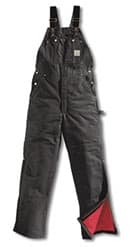
|
Hand Jive: Numb hands mean no feeling and a miserable day. If you want to keep your mitts toasty but still feel the bite, pick up a pair of 821-BK pre-curved slit-finger gloves from Glacier Glove. www.glacierglove.com
Hot Foot: White rubber fishing boots may keep your feet dry, but not warm. Extra-thick socks might do the trick, but if you want guaranteed feeling in your toes, try some battery-heated boot socks from Cabela’s. www.cabelas.com
Head Gear: To one-up a plain wool hat, crank the heat with a GORE-TEX Wigwam with a polypropylene insert. The outer material is waterproof and breathable, while the insert wicks moisture to transfer sweat away from your skin. www.gore-tex.com – J.C.









